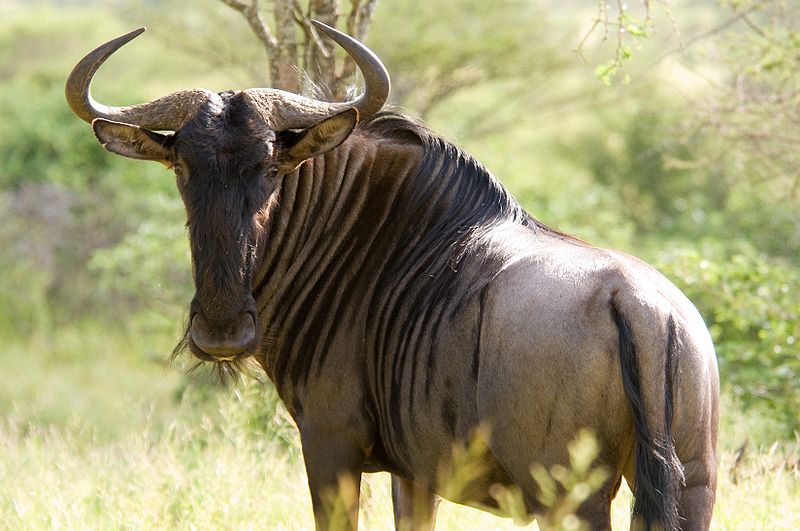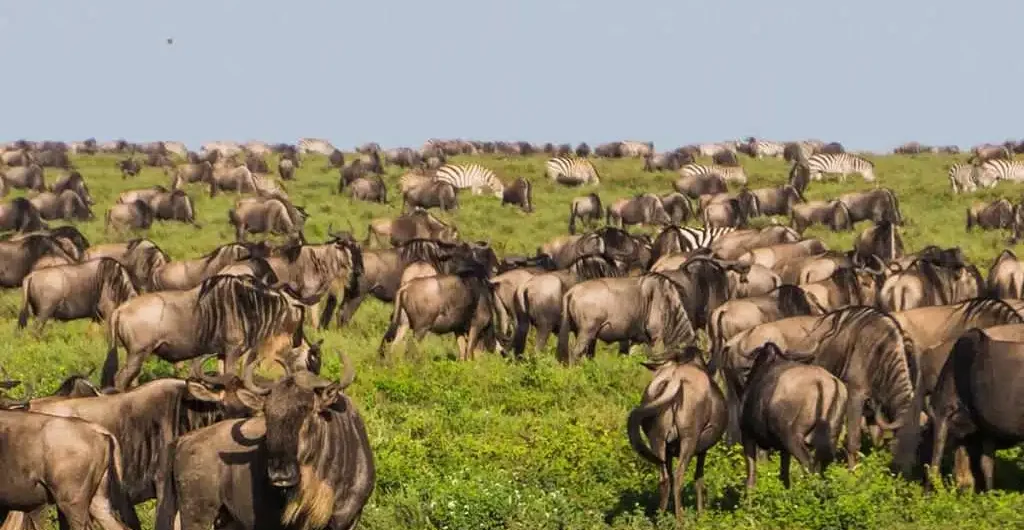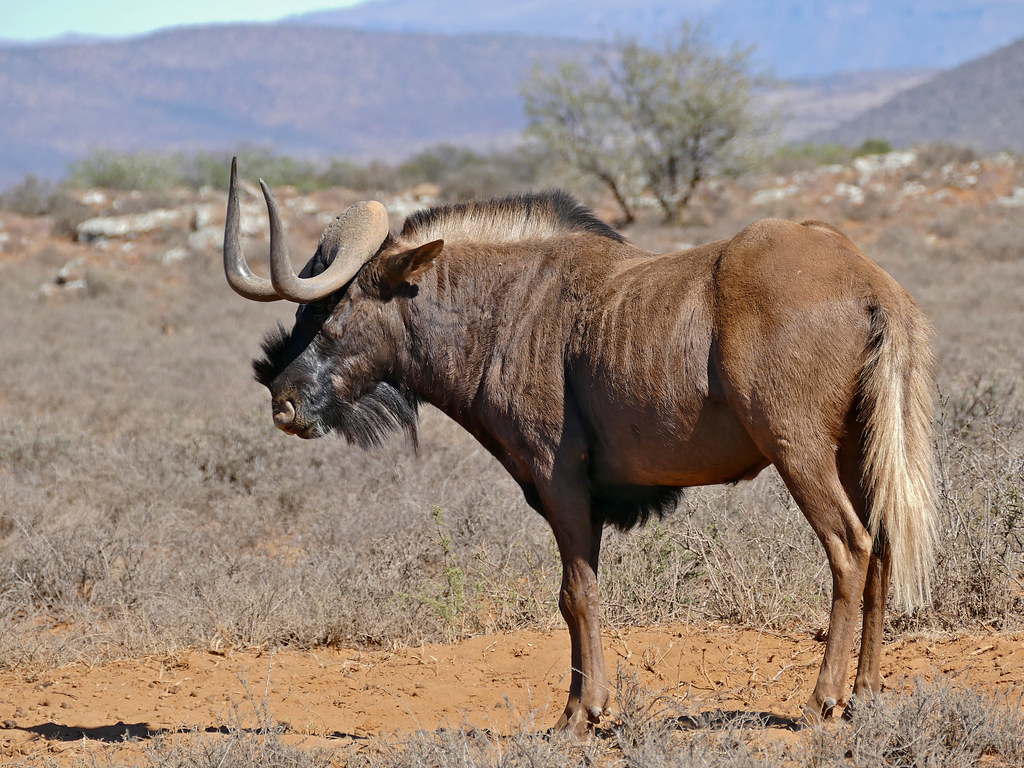While the Blue Wildebeest and the Black Wildebeest share some similarities as members of the same genus, they exhibit distinct physical characteristics, habitat preferences, behavior, and conservation status. The Blue Wildebeest is larger, migratory, and adapted to a variety of habitats, whereas the Black Wildebeest is smaller, territorial.
The African continent is home to a variety of wildlife species, including the wildebeest. Two notable species of wildebeest found in Africa are the Blue Wildebeest (Connochaetes taurinus) and the Black Wildebeest (Connochaetes gnou). While they belong to the same genus, there are distinct differences between these two species. In this article, we will compare and contrast the Blue Wildebeest and the Black Wildebeest, highlighting their physical characteristics, habitat preferences, behavior, and conservation status.
More about the blue wildebeests
1. Physical Characteristics
Blue Wildebeest: The Blue Wildebeest is larger and heavier than the Black Wildebeest. It has a robust build with a shoulder height of approximately 1.2 to 1.5 meters (3.9 to 4.9 feet) and can weigh between 180 and 270 kilograms (400 to 600 pounds). It is known for its distinctive large, curved horns that sweep back and upwards.

Black Wildebeest: The Black Wildebeest is smaller and lighter compared to the Blue Wildebeest. It has a shoulder height of around 1 to 1.2 meters (3.3 to 3.9 feet) and weighs between 110 and 180 kilograms (240 to 400 pounds). It has long, pointed, and slightly curved horns.
2. Habitat Preferences
- Blue Wildebeest: Blue Wildebeests prefer open grasslands, savannahs, and woodlands. They are often found in large herds, migrating long distances in search of grazing areas and water sources. They are well-adapted to a wide range of habitats and can tolerate both wet and dry conditions.
- Black Wildebeest: Black Wildebeests are adapted to semi-arid grasslands and open plains. They have a preference for shorter grasses and are well-suited to drier environments. Unlike the Blue Wildebeest, they do not migrate extensively and tend to stay in smaller groups or territorial herds.
3. Behavior and Social Structure
- Blue Wildebeest: Blue Wildebeests are highly social animals and form large herds that can consist of hundreds or even thousands of individuals. They exhibit synchronized movements during migration, often driven by the search for food and water. They communicate through a series of vocalizations, including grunts and snorts.
- Black Wildebeest: Black Wildebeests are also social animals but tend to form smaller herds or territorial groups consisting of a dominant male and several females. They are known for their territorial displays, which involve aggressive posturing, running, and engaging in “fencing” behavior with their horns.
4. Conservation Status
- Blue Wildebeest: The Blue Wildebeest is categorized as a species of “Least Concern” on the IUCN Red List of Threatened Species. They have a wide distribution across Africa and are relatively abundant in protected areas.
- Black Wildebeest: The Black Wildebeest is classified as a species of “Least Concern” as well. However, it has experienced population declines in the past due to hunting and habitat loss. Conservation efforts have helped stabilize their numbers, and they can be found in protected areas in South Africa and Namibia.
Distribution of Blue Wildebeest and Black Wildebeest
The Blue Wildebeest (Connochaetes taurinus) and the Black Wildebeest (Connochaetes gnou) have different distribution patterns across Africa. Let’s explore their respective ranges:
Blue Wildebeest Distribution:
- The Blue Wildebeest has a wide distribution and can be found in various countries across eastern and southern Africa.
- They are commonly found in countries such as Tanzania, Kenya, Zambia, Zimbabwe, Botswana, Namibia, and South Africa.
- Within these countries, Blue Wildebeests inhabit diverse habitats ranging from open grasslands and savannahs to woodlands.
- They are known for their extensive migrations, covering long distances in search of fresh grazing areas and water sources.
Black Wildebeest Distribution:
- The Black Wildebeest has a more limited distribution compared to the Blue Wildebeest.
- They are endemic to southern Africa and are primarily found in South Africa and Namibia.
- Historically, their range extended further, but habitat loss and hunting resulted in population declines and reduced their distribution.
- Black Wildebeests are well adapted to semi-arid grasslands and open plains, preferring areas with shorter grasses.
In summary, while the Blue Wildebeest has a broader distribution across eastern and southern Africa, the Black Wildebeest is restricted to specific regions in southern Africa, primarily South Africa and Namibia. Both species have their own unique habitats and play important ecological roles in their respective ranges.
Similarities Between Blue Wildebeest and Black Wildebeest
Despite their distinct physical characteristics and distribution patterns, the Blue Wildebeest (Connochaetes taurinus) and the Black Wildebeest (Connochaetes gnou) share some similarities. Let’s explore these similarities:
1. Genus and Taxonomy:
- Both the Blue Wildebeest and the Black Wildebeest belong to the same genus, Connochaetes, which is derived from the Greek words “conno” meaning “common” and “chaetes” meaning “mane.” This genus comprises two wildebeest species.
2. Family and Subfamily:
- Blue Wildebeests and Black Wildebeests are both members of the Bovidae family, which includes antelopes, cattle, goats, and sheep.
- They also belong to the Alcelaphinae subfamily, which consists of large herbivores with elongated heads and specialized grazing adaptations.
3. Social Behavior:
- Both species exhibit social behavior and form herds or groups, although their group dynamics differ.
- Blue Wildebeests are known for forming large herds consisting of hundreds or even thousands of individuals. These herds migrate together, providing safety in numbers and increased opportunities for finding food and water.
- Black Wildebeests, on the other hand, form smaller herds or territorial groups consisting of a dominant male and several females. They defend their territories and engage in aggressive displays to establish dominance.
4. Grazing Habits:
- Both species are primarily herbivores and have adapted to grazing on grasses as their primary food source.
- They possess specialized teeth and jaws that allow them to efficiently consume and process fibrous plant material.
5. Importance in Ecosystems:
- Both wildebeest species play crucial roles in their respective ecosystems. As large herbivores, they contribute to nutrient cycling and shape the structure of grassland habitats.
- Their grazing activities help maintain grassland ecosystems, prevent encroachment by shrubs and trees, and create opportunities for other species.
While there are noticeable differences between the Blue Wildebeest and the Black Wildebeest, these shared characteristics highlight their common ancestry and their significance in the African savannah ecosystems. Understanding both the similarities and differences between these species allows us to appreciate the biodiversity and ecological dynamics of Africa’s wildlife.
![]()



Comments